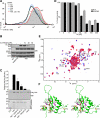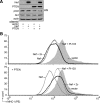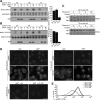Small molecule inhibition of HIV-1-induced MHC-I down-regulation identifies a temporally regulated switch in Nef action
- PMID: 20702582
- PMCID: PMC2947465
- DOI: 10.1091/mbc.E10-05-0470
Small molecule inhibition of HIV-1-induced MHC-I down-regulation identifies a temporally regulated switch in Nef action
Abstract
HIV-1 Nef triggers down-regulation of cell-surface MHC-I by assembling a Src family kinase (SFK)-ZAP-70/Syk-PI3K cascade. Here, we report that chemical disruption of the Nef-SFK interaction with the small molecule inhibitor 2c blocks assembly of the multi-kinase complex and represses HIV-1-mediated MHC-I down-regulation in primary CD4(+) T-cells. 2c did not interfere with the PACS-2-dependent trafficking of Nef required for the Nef-SFK interaction or the AP-1 and PACS-1-dependent sequestering of internalized MHC-I, suggesting the inhibitor specifically interfered with the Nef-SFK interaction required for triggering MHC-I down-regulation. Transport studies revealed Nef directs a highly regulated program to down-regulate MHC-I in primary CD4(+) T-cells. During the first two days after infection, Nef assembles the 2c-sensitive multi-kinase complex to trigger down-regulation of cell-surface MHC-I. By three days postinfection Nef switches to a stoichiometric mode that prevents surface delivery of newly synthesized MHC-I. Pharmacologic inhibition of the multi-kinase cascade prevents the Nef-dependent block in MHC-I transport, suggesting the signaling and stoichiometric modes are causally linked. Together, these studies resolve the seemingly controversial models that describe Nef-induced MHC-I down-regulation and provide new insights into the mechanism of Nef action.
Figures







Similar articles
-
An interdomain binding site on HIV-1 Nef interacts with PACS-1 and PACS-2 on endosomes to down-regulate MHC-I.Mol Biol Cell. 2012 Jun;23(11):2184-97. doi: 10.1091/mbc.E11-11-0928. Epub 2012 Apr 11. Mol Biol Cell. 2012. PMID: 22496420 Free PMC article.
-
HIV-1 Nef binds PACS-2 to assemble a multikinase cascade that triggers major histocompatibility complex class I (MHC-I) down-regulation: analysis using short interfering RNA and knock-out mice.J Biol Chem. 2008 Apr 25;283(17):11772-84. doi: 10.1074/jbc.M707572200. Epub 2008 Feb 22. J Biol Chem. 2008. PMID: 18296443 Free PMC article.
-
HIV-1 Nef assembles a Src family kinase-ZAP-70/Syk-PI3K cascade to downregulate cell-surface MHC-I.Cell Host Microbe. 2007 Apr 19;1(2):121-33. doi: 10.1016/j.chom.2007.03.004. Cell Host Microbe. 2007. PMID: 18005690
-
Structure, function, and inhibitor targeting of HIV-1 Nef-effector kinase complexes.J Biol Chem. 2020 Oct 30;295(44):15158-15171. doi: 10.1074/jbc.REV120.012317. Epub 2020 Aug 29. J Biol Chem. 2020. PMID: 32862141 Free PMC article. Review.
-
[The HIV nef and the Kaposi-sarcoma-associated virus K3/K5 proteins: "parasites"of the endocytosis pathway].Med Sci (Paris). 2003 Jan;19(1):100-6. doi: 10.1051/medsci/2003191100. Med Sci (Paris). 2003. PMID: 12836198 Review. French.
Cited by
-
An interdomain binding site on HIV-1 Nef interacts with PACS-1 and PACS-2 on endosomes to down-regulate MHC-I.Mol Biol Cell. 2012 Jun;23(11):2184-97. doi: 10.1091/mbc.E11-11-0928. Epub 2012 Apr 11. Mol Biol Cell. 2012. PMID: 22496420 Free PMC article.
-
Nef enhances HIV-1 replication and infectivity independently of SERINC5 in CEM T cells.Virology. 2023 Jan;578:154-162. doi: 10.1016/j.virol.2022.12.008. Epub 2022 Dec 23. Virology. 2023. PMID: 36577173 Free PMC article.
-
Association between HIV-1 Nef-mediated MHC-I downregulation and the maintenance of the replication-competent latent viral reservoir in individuals with virally suppressed HIV-1 in Uganda: an exploratory cohort study.Lancet Microbe. 2025 May;6(5):101018. doi: 10.1016/j.lanmic.2024.101018. Epub 2025 Mar 12. Lancet Microbe. 2025. PMID: 40088911 Free PMC article.
-
The accessory factor Nef links HIV-1 to Tec/Btk kinases in an Src homology 3 domain-dependent manner.J Biol Chem. 2014 May 30;289(22):15718-28. doi: 10.1074/jbc.M114.572099. Epub 2014 Apr 10. J Biol Chem. 2014. PMID: 24722985 Free PMC article.
-
The identification of a small molecule compound that reduces HIV-1 Nef-mediated viral infectivity enhancement.PLoS One. 2011;6(11):e27696. doi: 10.1371/journal.pone.0027696. Epub 2011 Nov 15. PLoS One. 2011. PMID: 22110726 Free PMC article.
References
-
- Arold S., Franken P., Strub M. P., Hoh F., Benichou S., Benarous R., Dumas C. The crystal structure of HIV-1 Nef protein bound to the Fyn kinase SH3 domain suggests a role for this complex in altered T cell receptor signaling. Structure. 1997;5:1361–1372. - PubMed
-
- Astoul E., Edmunds C., Cantrell D. A., Ward S. G. PI 3-K and T-cell activation: limitations of T-leukemic cell lines as signaling models. Trends Immunol. 2001;22:490–496. - PubMed
-
- Atkins K. M., Thomas L., Youker R. T., Harriff M. J., Pissani F., You H., Thomas G. HIV-1 Nef Binds PACS-2 to Assemble a Multikinase Cascade That Triggers Major Histocompatibility Complex Class I (MHC-I) Down-regulation: analysis using short interfering RNA and knock-out mice. J. Biol. Chem. 2008;283:11772–11784. - PMC - PubMed
Publication types
MeSH terms
Substances
Grants and funding
- T32 GM71338/GM/NIGMS NIH HHS/United States
- P50 GM082251/GM/NIGMS NIH HHS/United States
- AI14149/AI/NIAID NIH HHS/United States
- AI071798/AI/NIAID NIH HHS/United States
- GM060170/GM/NIGMS NIH HHS/United States
- GM82251/GM/NIGMS NIH HHS/United States
- AI57083/AI/NIAID NIH HHS/United States
- CA81398/CA/NCI NIH HHS/United States
- R01 DK037274/DK/NIDDK NIH HHS/United States
- R01 AI057083/AI/NIAID NIH HHS/United States
- R01 CA081398/CA/NCI NIH HHS/United States
- R01 GM060170/GM/NIGMS NIH HHS/United States
- DK37274/DK/NIDDK NIH HHS/United States
- T32 GM071338/GM/NIGMS NIH HHS/United States
- P50GM082251/GM/NIGMS NIH HHS/United States
- R01 AI071798/AI/NIAID NIH HHS/United States
- HFE-87760/CAPMC/ CIHR/Canada
LinkOut - more resources
Full Text Sources
Other Literature Sources
Research Materials
Miscellaneous

